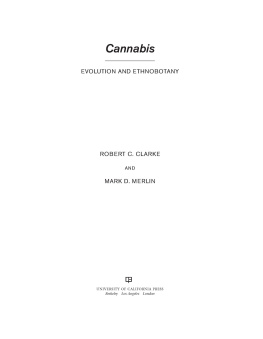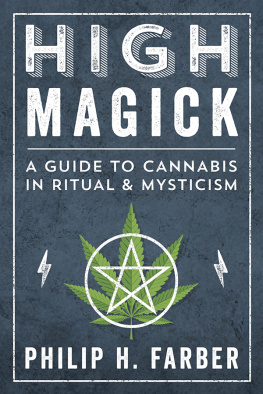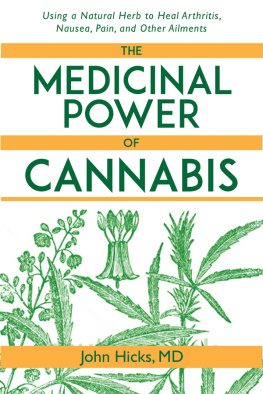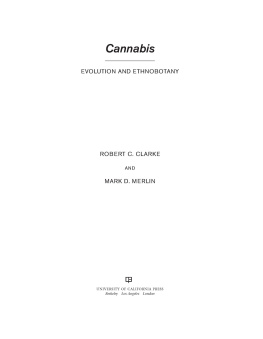
Cannabis
Cannabis

EVOLUTION AND ETHNOBOTANY
ROBERT C. CLARKE
AND
MARK D. MERLIN

UNIVERSITY OF CALIFORNIA PRESS
BerkeleyLos AngelesLondon
University of California Press, one of the most distinguished university presses in the United States, enriches lives around the world by advancing scholarship in the humanities, social sciences, and natural sciences. Its activities are supported by the UC Press Foundation and by philanthropic contributions from individuals and institutions. For more information, visit www.ucpress.edu.
University of California Press
Berkeley and Los Angeles, California
University of California Press, Ltd.
London, England
2013 by Robert C. Clarke and Mark D. Merlin
Limited hard cover edition, published 2013.
Library of Congress Cataloging-in-Publication Data
Clarke, Robert Connell, 1953
Cannabis : evolution and ethnobotany/Robert C. Clarke, Mark D. Merlin.
p. cm.
Includes bibliographical references and index.
ISBN 978-0-520-27048-0 (cloth : alk. paper)
eISBN 9780520954571
1. Cannabis. 2. CannabisEvolution. 3. CannabisUtilization. 4. Human-plant relationships. I. Merlin, Mark David. II. Title.
SB295.C35C54 2013
362.295dc232012036385
Manufactured in China
22 21 20 19 18 17 16 15 14 13
10 9 8 7 6 5 4 3 2 1
The paper used in this publication meets the minimum requirements of ANSI/NISO Z39.481992 (R 2002) (Permanence of Paper).
DEDICATION

Richard Evans Schultes (19152001) was born, raised, and worked most of his life in and around his beloved Harvard University, where he was an undergraduate and graduate student and then a longtime professor of botany and director of the Botanical Museum. However, Dick, as he liked us to call him, is best known for his 13 years of field research in the upper Amazon Basin, principally in Colombia. One of his several well-known and very accomplished graduate students, Wade Davis, wrote a well-received book ( One River, Simon & Schuster, 1996) that features the challenging and engaging experiences of Professor Schultes among numerous indigenous groups in remote tropical rainforest regions of northern South America. Readers are encouraged to read Daviss book and appreciate the zeal and fortitude of Schultess botanical and cultural explorations but, more important, to fathom the profound human-plant relationships of the native people whom he befriended and deeply respected. Schultes was especially sensitive to the ecological, spiritual, and medicinal plant relationships that indigenous peoples developed throughout the world. His profound research and mentorship have become almost legendary. The authors of this book are among the many students, scientists, and scholars who have been deeply inspired by the scientific goals and methodologies of our dear friend, Dick Schultes. We dedicate this book to his memory and celebrate his many contributions to ethnobotany of which he is certainly one of our modern founding fathers.
CONTENTS

PREFACE

Cannabis is one of the worlds most useful plant groups. It has been a part of human culture for thousands of years beginning in Eurasia, and today it is associated with people in almost all parts of the world. Although Cannabis is most often thought of as a drug plant, its use for a huge number of other purposes including fiber, food, paper, medicine, and so on is almost unparalleled, ranking it with the coconut palm and bamboos. Cannabis is truly a remarkable genus of multipurpose plants with extensive and complicated histories. A fully comprehensive, documented history of Cannabiss evolution and its widespread, diverse use by humans has never been published. This book is an attempt to accomplish that task. The evolution of Cannabis and the great variety of human- Cannabis relationships are presented here in greater depth than ever before. How this project developed and progressed is an interesting story in itself.
The coauthors have worked earnestly over the past 15 years or more to produce this book; however, they began to focus their scholarly and scientific interests on Cannabis well before their collaboration started in 1996. Both Mark Merlin and Robert Clarke first initiated their research on Cannabis while enrolled in undergraduate programs in the University of California system at their respective campuses decades ago. Their independent and joint field work involving the genus necessitated extensive travel across several continents to countless libraries and museums, complemented by innumerable interviews in regions where Cannabis has either ancient roots or only a relatively modern history of cultivation and use. This volume represents the better part of two scholarly careers spent following the historic trail of both the evolutionary biology and ethnobotanical heritage of Cannabis.
It is quite fitting that University of California Press has decided to publish this extensive body of research. Mark Merlins father graduated from UC Berkeley in 1925 with a bachelors degree in philosophy and Mark earned his undergraduate degree in history at UC Santa Barbara in 1967. Robert Clarkes mother was a budget analyst for UC San Diego and he received his degree in biology from UC Santa Cruz in 1976.
In the fall of 1967, as an incoming graduate student at the University of Hawaii at Manoa (UHM), Mark began to think about what topic he would choose to study for his masters thesis in geography. He had been exposed to the exponential rise in the use of psychoactive Cannabis in California in the second half of the 1960s. Out of almost nowhere the illicit smoking and eating of Cannabis began to spread at a phenomenal rateat UC Santa Barbara, across the state of California, in several other areas in North America, and beyond. Mark wondered, what is it about this drug plant that allowed it to become such an attractive item of recreational and spiritual interest over what seemed to him to be a very short time? Where did these plants come from, what were their geographical origins and what was their history of relationships with humans over time? And indeed why was Cannabis being so actively suppressed by governments across the globe?
Mark decided that the ancient history of human- Cannabis relationships would be an interesting topic and consulted with his graduate advisors at UHM. He informed them that he was inspired by the man-land (human-environment) tradition in geography and most specifically with the work of Carl O. Sauer, the UC Berkeley geographer who explored the origins of agricultural crops and how their relationships with humans changed landscapes far and wide over much of the planet. His advisors eventually gave Mark permission to pursue his academic goals. Mark spent the next two years carrying out research and writing a thesis that was accepted in 1969. Then with the support of two professors at UHM, one in the English department and another in the history department, Fairleigh Dickinson University Press published his thesis as a hardback book, Man and Marijuana: Some Aspects of Their Ancient Relationships, in 1972, and A. S. Barnes and Company published it as a paperback in 1973. The book was well received and is still a key resource for the early history of Cannabis.
Next page












